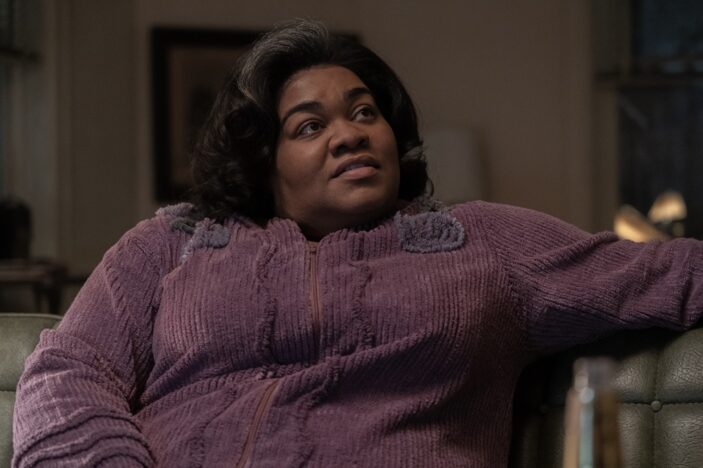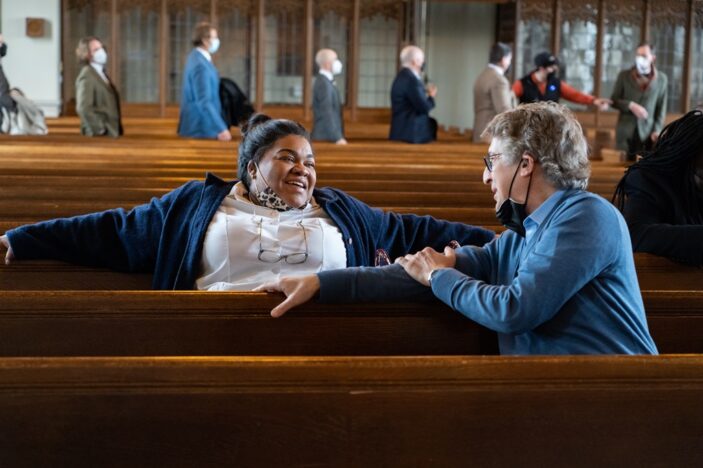
The Holdovers reunites Sideways’ director Alexander Payne and Paul Giamatti in a holiday story of three lonely, shipwrecked people at a New England boarding school over winter break in 1970. Giamatti stars as Paul Hunham, a curmudgeonly instructor who is forced to remain on campus during Christmas break to babysit the handful of students with nowhere to go. Eventually he forms an unlikely bond with one of them – a damaged, brainy troublemaker (newcomer Dominic Sessa) – as well as the school’s head cook (Da’Vine Joy Randolph in her Golden Globe Award-winning role), whose only child, a recent graduate, has been killed in Vietnam. Left to their own devices in the empty school, the three of them find adventure, calamity, and some semblance of family.
Speaking with Peter Gray ahead of the film’s local release, Randolph spoke about her research into the specifics of American history, navigating grief, and the unique habit she had to master to fulfil her character’s authenticity.
Your character, Mary, is someone who is torn apart by grief by the Vietnam war. It’s quite integral to American history. Did you have much knowledge of the war itself? Or did you research further in order to immerse yourself?
I did need to take a deeper look. But more importantly, I took a deeper look at just those three years in American history. 1968 to 1970 was a very, very bleak time in American history. When this movie takes place we would have just survived MLK’s assassination. And then, maybe a few weeks later, JFK’s assassination. A lot was going on. It was a sad, dark time.
I wanted to make it clear that (Mary) is very much living in a different, almost alternate universe from what these other folks are. In the sense that she’s an outsider being dropped into their reality. That’s why I think she has a love/hate relationship with these kids, because it’s not their fault. They were born into this, but because of how their parents raised them, they’re spoiled brats.
When you think about it, any person of colour that was fighting in the war, had little to no chance of (surviving). It meant something different when they were being shipped off to war. It’s very sad. Very sad, indeed.
There’s a beautiful understated, subtle demeanour you have to the performance. I think we almost expect bigger moments from her. How was it to navigate that internalisation of her pain?
There were some takes where she was full-on crying, and that could have been very well deserved and made sense, but I think it just took us to tinker with it, and as it went on we realised what was working and what wasn’t. We began to understand, and it was something that I was told when I was younger in school, you get more out of something if you show the fight in it, as opposed to giving it all out, you know? You get an audience to lean in more when you’re fighting back the tears. That was something I knew I wanted to play with. I didn’t know how difficult that was going to be. I even knew myself, I was like, “Argh, please let her release something!”
It was a good uncomfortable, if that makes sense? It was needed. It’s the way she lives her life. Someone said this to me, and I’m going to take it with me forever, “There’s a privilege in showing emotion.” And she doesn’t have that privilege. That speaks to how she operates, and how the world operated for her that she was living in.

We see that pain that she’s carrying. And in that era the loss of a son was so common. I wanted to ask specifically about personifying that universal pain, that universal wound, that so many people have yet to heal from, unfortunately.
They say one of the hardest things is for a parent to bury their child. It’s unnatural. Just to briefly share something personal, my cousin unexpectedly passed away, and my aunt, we believe her grief was so significant that in the moments after she was diagnosed with cancer. We didn’t believe it happened, because she was diagnosed, but we believe that she was slowly dying of a broken heart. She kept it all in. I reference her a lot. I reference my grandmother who was, unbeknownst to me, quietly suffering in pain and sickness. She had debilitating arthritis, and I didn’t know. I was young so I was in my own world, but I say that as she was able to still be there for me, to play with me, and I’m thinking of how painful that must’ve been.
She passed when I was, like, 14 or 15-years-old, so it wasn’t until the last few years of her life, when I was old enough to begin to understand what that was. It blew me away for both of them. That these are two women who are suffering quietly. My parents didn’t let me know she had cancer until many years in it. There’s something about anyone, but in particular in my life, women, who will, for the sake of their family, continue on in spite of themselves. In spite of their pain. And that was something I really wanted to latch on to, and find these super secret, soft moments in which (Mary) could slowly process for a moment. That’s why I think those silent moments are so beautiful.
To me, I’m in two movies. I’m in a movie where we are talking. And then I’m in a silent movie, and that was a skill I had to quickly learn and adapt to. This idea of having to tell an equally, if not more, vivid a story with no words. And this idea of the viewer eavesdropping on me, almost. We really wanted to encapsulate that feeling. Almost as if you’re walking down a hallway and you happen to pass by and see her, you know what I mean? She’s in her room, and you just zoom in on what she’s thinking and feeling. It was hard, but it was one of the beautiful challenges we get (in) the opportunity to show these beautiful characters.
Thank you for sharing that. On the mention of challenges, I understand you had to cook, and smoke, for real in this? How did you find that experience?
It was very important for me. I was more keen about the cooking. Alexander (Payne) was more keen for the smoking, in regards for what needed to be real (laughs). When we discussed it, and when I was reading the script I was like, “Wow, there’s a lot of food here listed”, and I personally love to cook, so when we had our meeting I asked if it was possible. (Alexander) loves to cook, so he asked me if I wanted to, and I said “Absolutely.”
He knew it was going to ground my character, and that it was important for me to show that she wasn’t just a cook. She ran that culinary department. She knew what she was doing. She had a great skill. And a great ease and efficiency in running that kitchen. We had great fun. He allowed me to pick out the Christmas menu, and we were able to cook the food, and we worked with the ladies that helped us create all the dishes. It was really fun, the scene where (Paul Giamatti, Dominic Sessa and I are) eating Christmas dinner, because we didn’t eat our catering food that day, we actually sat down and ate dinner (together). It was really sweet.
And the smoking? Look, you can fake smoking, but not if your character is supposed to be an avid smoker. On top of that, she’s dealing with a lot, and so her fragile emotional state means she’s smoking even more than usual. We knew quite early on that we couldn’t fake it. Two days after I got the job, Alexander had shipped me two large boxes of fake cigarettes, so I had about five weeks to learn how to become comfortable with it. I watched some old movies to see how they held (the cigarettes). When it came time to shoot, I made the decision to transition to real cigarettes, because the weight of the fake ones were too flimsy and they easily broke. You could tell on camera that it wasn’t looking right. I found a light pack, and those became very helpful to me.
Cooking is something I do, but smoking is something I don’t, so I needed to become comfortable in embodying someone that looked as if they had been doing it for years. I had to practice the ease of it, as well as the rhythm of when you need to take a puff.
The Holdovers is screening in Australian theatres from January 11th, 2024.
